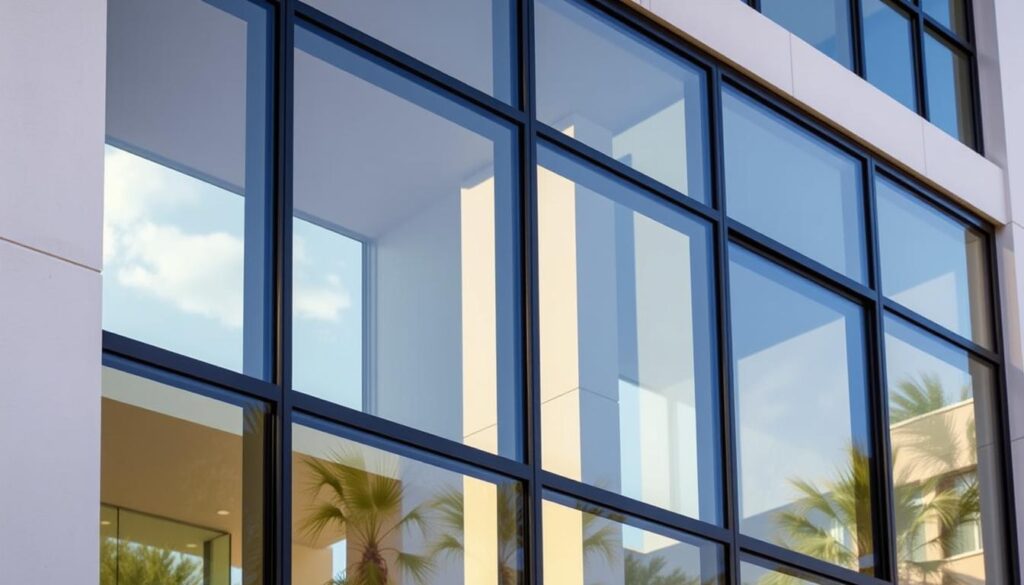Are you prepared to protect your home or business from the devastating effects of high winds and flying debris? Installing hurricane resistant glazing systems is a crucial step in safeguarding your property. With the increasing frequency of severe weather events, it’s essential to understand the importance of impact resistant windows and how to install them effectively.
For those living in hurricane-prone areas, such as Florida, USA, properties within one mile of the coastline require impact-resistant and wind-resistant glazing to withstand wind speeds upwards of 140mph. Our step-by-step guide will walk you through the process of installing hurricane-resistant glazing systems, ensuring your property remains secure and protected.
Key Takeaways
- Understand the importance of hurricane-resistant glazing systems for protecting your property.
- Learn how to install impact-resistant windows effectively.
- Discover the benefits of using hurricane-resistant glazing systems, including protection against high winds and flying debris.
- Find out how to choose the right glazing configuration for your property.
- Understand the testing and certification processes for hurricane-resistant glazing systems.
Understanding Hurricane Resistant Glazing Systems
Understanding the nuances of hurricane resistant glazing is crucial for homeowners and builders alike in hurricane-prone areas. Hurricane resistant glazing systems are engineered to be safer and withstand more extreme weather conditions than windows with standard glass.
Definition and Purpose
Hurricane resistant glazing, often referred to as impact resistant glazing, is designed to withstand the high winds and debris associated with hurricanes. Its primary purpose is to prevent damage to the building envelope, thereby reducing the risk of injury and property damage.
For more detailed information on hurricane windows, you can visit Pella’s resource on understanding hurricane windows.
Types of Glazing Systems
There are several types of stormproof windows and glazing systems available, including laminated glass, polycarbonate panels, and acrylic glazing. Each type has its unique characteristics and benefits, catering to different needs and applications.
- Laminated glass is known for its strength and ability to hold together even when broken.
- Polycarbonate panels offer high impact resistance and are often used in high-risk areas.
- Acrylic glazing provides a lightweight alternative with good optical clarity.
Benefits of Hurricane Resistant Glazing
The benefits of hurricane proof glass and other hurricane resistant glazing systems are multifaceted. They not only enhance the safety and security of a building but also offer energy efficiency and UV protection. By installing hurricane resistant glazing, property owners can significantly reduce the risk associated with extreme weather events.
Key Features of Hurricane Resistant Glazing
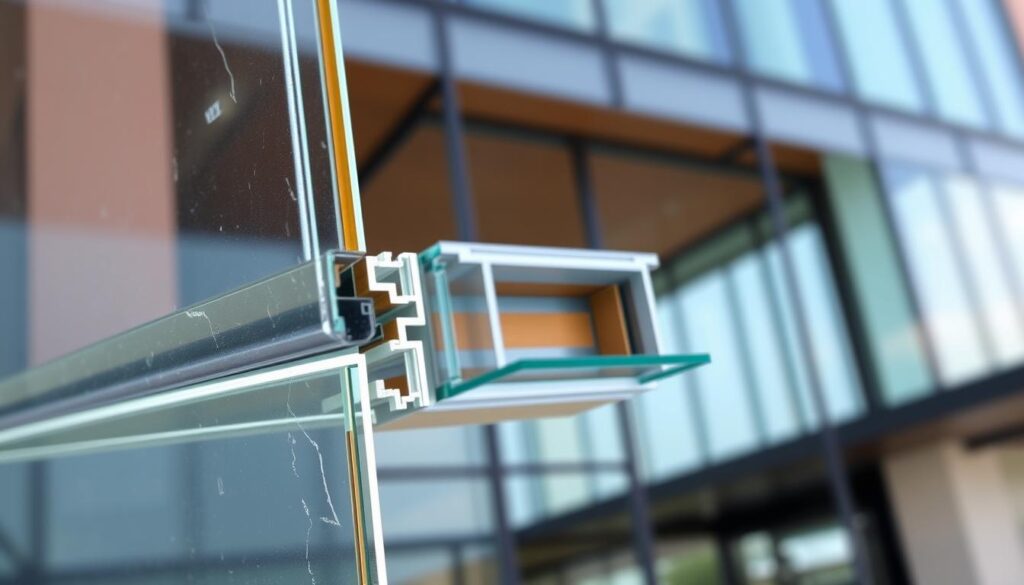
The effectiveness of hurricane resistant glazing lies in its key features, which include impact resistance, thermal performance, and UV protection. These features are crucial in ensuring that the glazing systems can withstand extreme weather conditions and provide long-term benefits to homeowners.
Impact Resistance
One of the primary features of hurricane rated windows is their impact resistance. The laminated pane of glass in these windows is made from two pieces of glass reinforced with a strong, yet flexible, polymer layer in between. This construction allows the glass to absorb impact without shattering, thereby preventing debris from entering the home. As stated by experts, “The use of laminated glass in hurricane resistant fenestration significantly enhances the safety and security of buildings.” Learn more about hurricane resistant windows.
Thermal Performance
In addition to impact resistance, hurricane resistant glazing also offers excellent thermal performance. The advanced materials used in these systems help to reduce heat transfer, keeping homes cooler in the summer and warmer in the winter. This can lead to significant energy savings over time. Some of the benefits include:
- Reduced energy consumption
- Lower utility bills
- Enhanced comfort within the home
UV Protection
Another key feature of hurricane resistant fenestration is its ability to protect against ultraviolet (UV) radiation. The specialized glass and coatings used in these systems block a significant portion of UV rays, which can cause fading and damage to interior furnishings. This protection helps to preserve the integrity and appearance of interior decor.
In conclusion, the key features of hurricane resistant glazing make it an indispensable component in buildings located in storm-prone areas. By understanding these features, homeowners and builders can make informed decisions about their glazing needs.
Building Codes and Regulations
Hurricane-resistant glazing systems are subject to stringent building codes and regulations, particularly in coastal regions. The stringent code requirements of Florida and other coastal regions require that the building envelope be maintained during a hurricane.
Local Building Codes
Local building codes vary significantly across different regions, with areas prone to hurricanes having more stringent requirements. For instance, Florida’s Building Code mandates the use of hurricane-resistant glass windows and hurricane-proof building materials in new constructions and renovations.
It’s essential to familiarize yourself with the local building codes and regulations in your area to ensure compliance.
Federal Guidelines
In addition to local codes, federal guidelines also play a crucial role in shaping the standards for hurricane-resistant glazing. These guidelines often provide a baseline that local codes can build upon or reference.
Federal agencies, such as the Federal Emergency Management Agency (FEMA), provide resources and guidelines for constructing buildings that can withstand natural disasters, including hurricanes.
Importance of Compliance
Compliance with both local and federal building codes is not just a legal necessity but also crucial for ensuring the safety and durability of buildings.
Using hurricane-proof building materials and adhering to established guidelines can significantly reduce the risk of damage during a hurricane, protecting both the structure and its occupants.
Materials Used in Hurricane Resistant Glazing

The construction of hurricane resistant glazing involves a combination of materials that offer strength, flexibility, and weather resistance. These materials are crucial in providing the necessary protection against extreme weather conditions.
Laminated Glass
Laminated glass is a key component in hurricane resistant glazing systems. It is made by sandwiching a layer of polyvinyl butyral (PVB) between two layers of glass. This construction provides impact resistance and helps to hold the glass together even when it is broken. Oldcastle BuildingEnvelope supplies all the main types of laminated glass used for hurricane-resistant applications.
For more information on the materials used in structural glass, you can visit this resource.
Polycarbonate Panels
Polycarbonate panels are another material used in hurricane resistant glazing. They are lightweight, yet incredibly strong, making them an ideal choice for withstanding high winds and debris impact. These panels are often used in conjunction with laminated glass to enhance the overall performance of the glazing system.
Sealants and Framing Materials
The sealants and framing materials used in hurricane resistant glazing are also critical to its performance. Sealants are used to create a watertight seal around the glazing panels, preventing water intrusion and reducing the risk of damage. Framing materials, such as aluminum or steel, provide the structural support needed to withstand wind loads and other external forces.
The selection of materials for hurricane resistant glazing is based on their ability to work together to provide a robust and durable system. By understanding the properties and benefits of each material, builders and homeowners can make informed decisions when choosing a glazing system for their needs.
Preparing for Installation
The success of hurricane resistant fenestration installation hinges on thorough preparation. Assessing needs and specifications is the first step in hurricane window installation, ensuring that the glazing system meets the specific requirements of the building and complies with local building codes.
Assessing Site Conditions
Before installing stormproof windows, it’s essential to assess the site conditions to determine the most suitable glazing system. This involves evaluating the building’s orientation, wind patterns, and potential impact zones.
- Evaluate the building’s design and structure.
- Assess the local wind patterns and potential debris impact.
- Consider the climate and weather conditions.
Choosing the Right Glazing System
Selecting the appropriate hurricane resistant fenestration involves considering several factors, including the level of impact resistance required, thermal performance, and UV protection.
| Glazing System | Impact Resistance | Thermal Performance |
|---|---|---|
| Laminated Glass | High | Good |
| Polycarbonate Panels | Very High | Excellent |
Tools and Equipment Checklist
Having the right tools and equipment is crucial for a successful installation. The following checklist ensures that you are well-prepared.
- Drilling equipment and bits.
- Sealants and adhesives.
- Safety gear, including gloves and goggles.
By carefully assessing site conditions, choosing the right glazing system, and preparing a comprehensive tools and equipment checklist, you can ensure a smooth and effective installation process for your hurricane resistant fenestration.
Installation Process Overview
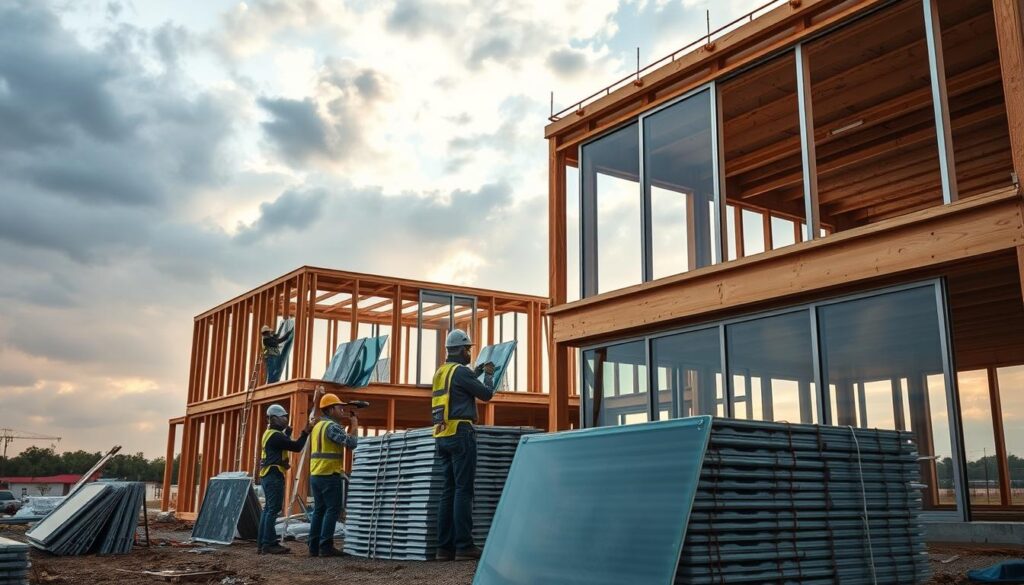
A successful installation of hurricane-resistant glazing systems hinges on a thorough understanding of the process. This involves several key steps and considerations to ensure that the final product is both effective and durable.
Step-by-Step Installation Guide
The installation process begins with the removal of old windows, followed by securing the frame, a critical step as it provides the foundation for the new hurricane proof glass. Ensuring the frame is secure and properly prepared is essential for the successful installation of hurricane rated windows.
Once the frame is secured, the next step involves installing the glazing panels. This requires careful handling to avoid damage and precise positioning to ensure a proper fit.
Safety Precautions
Safety is paramount during the installation process. Installers should wear appropriate protective gear, including gloves and safety glasses, to protect against injuries from glass shards or tools.
It’s also crucial to ensure that the work area is well-ventilated and clear of debris to prevent accidents.
Common Mistakes to Avoid
One of the most common mistakes during installation is failing to secure the frame properly. As noted, securing the frame is crucial once the old windows are removed, as it directly impacts the integrity of the new glazing system.
Another mistake is not following the manufacturer’s instructions for the specific hurricane rated windows being installed. This can lead to improper fitting and reduced effectiveness of the glazing system.
Installing Frame Systems
The frame system is the backbone of any hurricane resistant glazing installation, providing the necessary structural integrity. A properly installed frame ensures that the glazing system can withstand the forces exerted by hurricanes.
Types of Frame Systems
There are several types of frame systems used in hurricane resistant glazing installations, including:
- Aluminum frames, known for their durability and corrosion resistance.
- Steel frames, which offer high strength and can be used in a variety of applications.
- Vinyl frames, providing a good balance between cost and performance.
Each type of frame has its advantages and is suited to different project requirements. For instance, aluminum frames are often used in commercial buildings due to their corrosion resistance and aesthetic appeal.
Frame Preparation
Before installing the frame, it is crucial to prepare it properly. This involves:
- Inspecting the frame for any damage or defects.
- Cleaning the frame to ensure a proper seal.
- Applying a protective coating to enhance durability.
Using corrosion-resistant screws and anchors is advisable to enhance the durability of the frame system, as mentioned in the manufacturer’s guidelines. This is particularly important in coastal areas where the risk of corrosion is higher.
Installing the Frame
The actual installation of the frame involves several key steps:
- Positioning the frame accurately according to the design specifications.
- Securing the frame using appropriate anchors and screws.
- Ensuring the frame is level and plumb.
For more detailed information on hurricane resistant glazing systems, including frame installation best practices, refer to the manufacturer’s resources.
Installing the Glazing Panels

Proper installation is crucial for the effectiveness of hurricane resistant glazing systems. This process involves several critical steps to ensure that the glazing panels perform optimally.
Panel Handling and Transport
Handling and transporting hurricane resistant glass windows requires care to prevent damage. It’s essential to use appropriate equipment and follow safety guidelines to avoid accidents and ensure the panels remain intact.
- Use suction cups or similar devices to handle large panels.
- Ensure panels are securely wrapped and protected during transport.
- Keep panels upright and supported to prevent bending or cracking.
Positioning the Panels
Accurate positioning of the glazing panels is vital for their performance. The panels must be aligned correctly with the frame to ensure a proper fit and seal.
For more information on hurricane resistant glazing systems, visit our product page here.
| Positioning Considerations | Importance | Best Practices |
|---|---|---|
| Alignment with Frame | High | Use alignment tools to ensure precise fitting. |
| Spacing Between Panels | Medium | Maintain uniform spacing for aesthetic and functional purposes. |
| Panel Leveling | High | Use leveling tools to ensure panels are perfectly horizontal or vertical as required. |
Securing the Panels
Once the panels are correctly positioned, they must be securely fastened to the frame. This step is critical to ensure that the stormproof windows can withstand extreme weather conditions.
Securing involves using the appropriate fasteners and sealants. It’s crucial to follow the manufacturer’s instructions and local building codes to ensure compliance and effectiveness.
Creating Weather Seals
To prevent water and air infiltration, it’s essential to create robust weather seals around glazing systems. This step is crucial in ensuring the overall effectiveness of hurricane-resistant glazing and maintaining the integrity of the building envelope.
Importance of Weather Seals
Weather seals are vital in preventing damage from wind-driven rain and air leaks that can compromise the structural integrity of a building. By sealing gaps and joints around impact-resistant glazing, you can significantly reduce the risk of water intrusion and associated damage.
Moreover, effective weather seals contribute to energy efficiency by minimizing air leakage, which can lead to heat loss in winter and heat gain in summer. This not only enhances the comfort of the building’s occupants but also reduces energy consumption.
Sealant Options
Choosing the right sealant is critical for creating durable weather seals. Common sealant options include silicone, polyurethane, and acrylic-based products. Silicone sealants are particularly popular due to their flexibility, durability, and resistance to weathering.
When selecting a sealant, consider factors such as compatibility with the glazing material, exposure to UV radiation, and the expected movement of the glazing system due to wind loads or thermal expansion.
Application Techniques
Proper application techniques are essential for achieving effective weather seals. Ensure that the surface is clean, dry, and free of contaminants before applying the sealant. Use a backer rod to control the depth of the sealant and promote a tight seal.
Apply the sealant in a continuous bead, using a caulking gun or similar tool. Tool the sealant to ensure it is pressed into the joint and smoothed out to prevent dirt accumulation.
By following these guidelines and using high-quality hurricane proof building materials, you can create effective weather seals that enhance the performance and durability of your glazing system.
Conducting Post-Installation Inspections
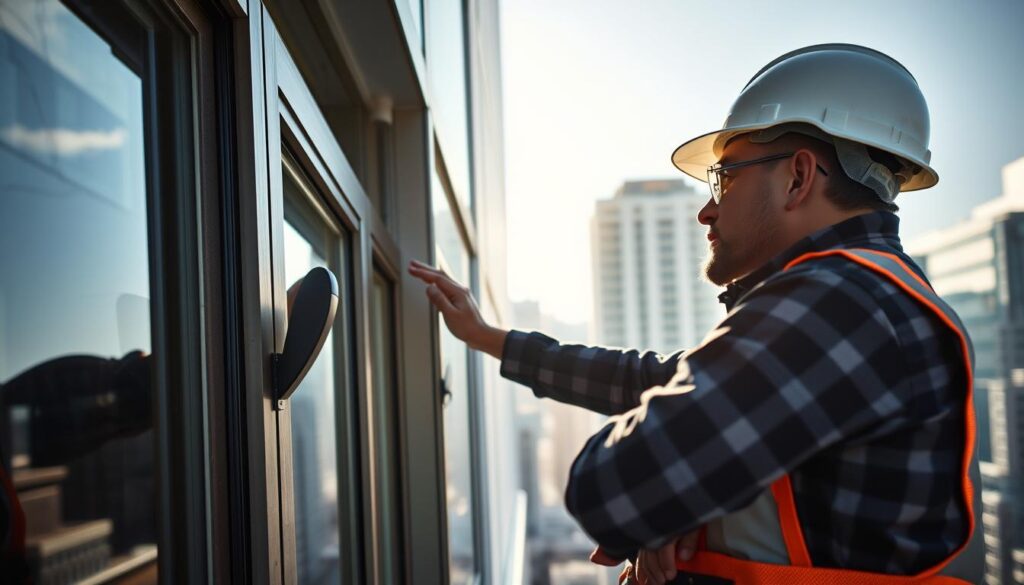
Once the installation of hurricane resistant glazing is complete, a detailed inspection is necessary to check for any gaps, ensure structural integrity, and make any necessary adjustments. This step is crucial in guaranteeing that the hurricane resistant fenestration system functions as intended, providing maximum protection against extreme weather conditions.
Inspecting for Gaps and Seals
A thorough inspection for gaps and seals is vital to prevent water intrusion and ensure the energy efficiency of the building. Inspectors should check all joints and seals around the hurricane rated windows, verifying that they are properly sealed and that there are no gaps or cracks.
- Check the seals around the glazing panels for any signs of damage or deterioration.
- Verify that all joints are properly filled with sealant and that there are no gaps.
- Inspect the framing for any signs of warping or damage that could compromise the seal.
Ensuring Structural Integrity
Ensuring the structural integrity of the hurricane resistant glazing system is critical to its performance and longevity. Inspectors should verify that all components are properly installed and that the system can withstand the stresses imposed by high winds and flying debris.
| Component | Inspection Criteria | Acceptable Condition |
|---|---|---|
| Glazing Panels | Properly secured, no damage | No cracks, securely fastened |
| Framing | No warping, properly aligned | Straight, level, and securely attached |
| Sealants | Properly applied, no gaps | Uniform, continuous seal |
Final Adjustments and Touch-Ups
After completing the inspection, any necessary adjustments or repairs should be made to ensure that the hurricane resistant glazing system is functioning optimally. This may include tightening loose fasteners, applying additional sealant, or making minor repairs to damaged components.
“A well-installed hurricane resistant glazing system not only enhances the safety and security of a building but also contributes to its overall energy efficiency and aesthetic appeal.”
By following these steps and conducting a thorough post-installation inspection, builders and homeowners can have confidence in the performance and durability of their hurricane resistant fenestration systems.
Maintenance for Hurricane Resistant Glazing
Proper maintenance of hurricane-resistant glazing systems is key to their ability to withstand extreme weather conditions. Regular upkeep ensures that these systems continue to provide protection and performance over their lifespan.
Routine Checks
Conducting routine checks is essential for maintaining the integrity of impact-resistant windows. Inspect the glazing systems for any signs of wear, such as cracks, delamination, or seal failure. It’s also important to check the framing and mounting hardware for any signs of deterioration or loosening.
For detailed guidance on maintaining your hurricane glazing, you can refer to resources like hurricane-proof glass upkeep.
Identifying Damage
Early identification of damage is crucial for preventing further issues. Look for signs such as water intrusion, fogging between glass layers, or visible cracks. If you notice any of these issues, it’s important to address them promptly to maintain the system’s effectiveness.
Repairing and Replacing Components
When damage is identified, it’s essential to either repair or replace the affected components. For minor issues, such as tightening loose hardware, this can be done by homeowners. However, more significant repairs or replacements, especially those involving the glazing panels themselves, may require professional assistance to ensure that the system’s integrity is maintained.
Regular maintenance not only extends the life of your hurricane-resistant glazing systems but also ensures they continue to provide the necessary protection during extreme weather events.
Cost Considerations
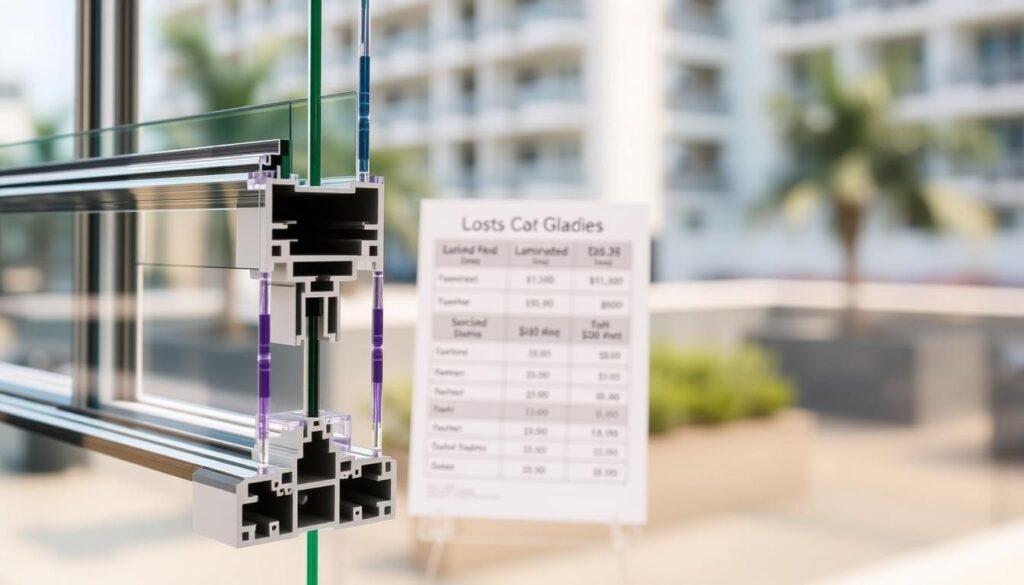
Understanding the cost implications of hurricane-resistant glazing systems is crucial for homeowners and builders alike. The financial investment in such systems can be significant, and it’s essential to consider various factors that influence the overall cost.
Factors Influencing Cost
Several factors can affect the cost of hurricane-resistant glazing systems. These include:
- The size and number of windows being replaced or installed
- The type of glazing material chosen (e.g., laminated glass, polycarbonate)
- The complexity of the installation process
- Local labor costs and building codes
Material costs can vary significantly depending on the type and quality of the glazing material. For instance, hurricane proof glass is typically more expensive than standard glass due to its enhanced durability and impact resistance.
Budgeting for Installation
When budgeting for the installation of hurricane-resistant glazing systems, it’s crucial to consider both the upfront costs and the potential long-term savings. Homeowners should:
- Obtain quotes from multiple contractors to compare prices
- Consider the energy efficiency of the glazing system, as it can lead to savings on utility bills
- Explore available incentives, such as tax credits or insurance discounts, for installing hurricane-resistant windows
Data suggests that installing hurricane impact windows can help reduce insurance costs, providing a potential long-term financial benefit.
Long-Term Savings
While the initial cost of hurricane-resistant glazing systems can be higher than traditional windows, there are several ways these systems can lead to long-term savings. These include reduced energy costs due to improved thermal performance, lower maintenance costs due to the durability of the materials, and potential reductions in insurance premiums.
By investing in hurricane-resistant windows, homeowners can not only enhance the safety and security of their properties but also potentially save money over time.
Conclusion
Installing hurricane resistant glazing systems is a significant investment in the safety and resilience of your home. By understanding the key features and benefits of these systems, homeowners can make informed decisions about their installation.
Key Takeaways from Installation Steps
The installation process involves several critical steps, including preparing the site, choosing the right glazing system, and ensuring proper sealing and framing. Following these steps carefully is essential for maximizing the effectiveness of hurricane resistant glazing systems.
Seeking Professional Help
While DIY installation is possible, seeking professional help can be invaluable, especially for complex installations or when dealing with local building codes and regulations. Professionals can ensure that the impact resistant glazing is installed correctly, providing optimal protection against hurricanes.
Final Considerations
In conclusion, hurricane resistant glazing systems offer a robust solution for homeowners looking to enhance their home’s resilience to extreme weather conditions. By investing in these systems and following proper installation and maintenance procedures, homeowners can enjoy long-term benefits, including improved safety and reduced maintenance costs.
